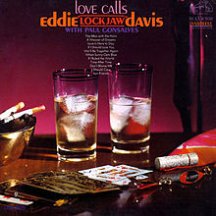 Love Calls RCA Victor LSP-3882 STEREO & LSM-3882 (MONO),br. Reissued 1995 - RCA Victor 74321257292 & BMG (CD-37350) Recorded 1963, London, UK |
Personnel
Eddie "Lockjaw" Davis - Tenor Saxophone Paul Gonsalves - Tenor Saxophone Everett Barksdale - Guitar Roland Hanna - Piano Ben Tucker - Bass Grady Tate - Drums |
Track Listing
1. Love is Here to Stay (G. & I. Gershwin) 2. When Sunny Gets Blue (Fisher & Segal) 3. If I Ruled the World (Bricusse & Ornadel) 4. Time After Time (Cahn & Styne) 5. Just Friends (Klenner & Lewis) 6. Don't Blame Me (McHugh & Fields) 7. I Should Care (Stordahl, Weston & Cahn) 8. The Man with the Horn (DeLange, Jenney & Lake) 9. We'll Be Together Again (Fischer & Laine) 10. A Weaver of Dreams (Elliott & Young) 11. If I Should Lose You (Rainger & Robin) |
If you know these two men only by hearsay, you may have reservations about them as balladeers. They both have reputations for derring-do of a different kind. Davis has never hesitated to do battle with the most frenetic performers, with those who would stick at nothing to win, and lost—to him. And Gonsalves was the hero of one of the great nights in jazz history, when he blew twenty-seven romping, stomping choruses on Duke Ellington's Diminuendo and Crescendo in Blue at Newport in 1956, and broke it up so completely, so uproariously, that reports of his triumph reverberated around the world, in the columns of Time, in organs of good and ill repute, and wherever the ability to recognize a news story existed.
It is easy for the jazzman to become typed, so that the public demands the repeated display of just one particular facet of his talent. This has happened to the two men showcased in this album, where the other side of their musical personalities is brought into focus. Both of them belong to what might be called the second generation of jazz tenor players. Although they have since developed highly individual styles, their original sources of inspiration were masters of the ballad—Ben Webster in Davis' case, Coleman Hawkins in that of Gonsalves. These influences were complementary to a degree, but the disciples have diverged still further through the years.
Their different approaches to the ballad make this recording consistently interesting and surprising. Both are soulful, both are rhapsodical. But Davis plays with clear, confident articulation, a buzz in his tone, and a bite in his phraseology. Generally, he is the more driving and passionate of the two. The Gonsalves style is, on the other hand, sinuous, insinuating and less direct. His imaginative lyricism is more tender and often melancholy, his tone well-produced and finely rounded. Despite these contrasting qualities, the game of identification becomes intriguing (but not really difficult) when they sometimes echo, adopt or adapt each other's ideas. Maybe to rid the listener of any doubt, or maybe in lieu of more formal introduction, each plays one number by himself. Don't Blame Me is all Gonsalves, We'll Be Together Again all Davis.
Elsewhere, the roles are always being reversed. On If I Ruled the World, a number Davis liked when he heard Tony Bennett sing it, Gonsalves "sings" the melody while his colleague blows a hip commentary. On / Should Care, Davis takes care of the theme and Gonsalves the improvised obbligato.
In most of the other performances, they play, as it were, in tandem. One exposes the number's melodic potential, and the other follows, improvising on it. Thus Davis is the first soloist on the opening selection, Love Is Here to Stay, Gonsalves the second. After the introduction, a brief flourish of virtuosity, Gonsalves is first on When Sunny Gets Blue, Davis second. And so on.
The breathy sub-tone, which Gonsalves uses so well, adds a curiously confidential and intimate dimension. It is like the musical equivalent of a whispered aside or a delicate suggestion. But both men alternate very adroitly between the discreet and the bold. Their mutual understanding is, in fact, positively uncanny at times, for they had never previously recorded together, and preparation before the sessions was minimal. In the studio, their long-term professionalism stood them in good stead, as did that of their four accompanists, whose taste and sensitivity contribute so much to the recording's appeal. Never obtrusive, they remain in close, listening support, Hanna and Barksdale being quick to prolong or emphasize the thoughts of the two soloists.
Slow tempos and ballads often imply background music for conversation. Such is not the case here. There is some restraint, certainly, but there is also emotion, latent and eruptive. Best heard during the hours when love calls, this is music that improves with familiarity.
Frank Challis

Made in RapidWeaver